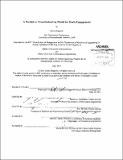A predictive troubleshooting model for early engagement
Author(s)
Bergevin, Glenn (Glenn Michael)
DownloadFull printable version (8.719Mb)
Other Contributors
Leaders for Global Operations Program.
Advisor
Martin L. Culpepper and Roy Welsch.
Terms of use
Metadata
Show full item recordAbstract
Raytheon Integrated Defense Systems (IDS) is home to Circuit Card Assembly, the department responsible for the production of circuit card assemblies from across all of Raytheon's businesses. Circuit Card Assembly includes manufacturing, test, quality, finance and other groups, functioning as its own business within Raytheon IDS. Circuit Card Assembly competes with external vendors for contracts from Raytheon businesses outside of IDS, thus the pursuit of competitive advantage in the form of technology, quality and throughput is a continuous activity. Circuit Card Assembly spends upwards of a million dollars each year on troubleshooting circuit card assemblies that fail first pass testing, in labor alone, with additional costs associated with reprocessing and material replacement. This thesis describes the creation of a design tool that improves electrical design for test, reducing wasteful troubleshooting on hundreds of products each year, saving tens of thousands of dollars on high cost programs, with incremental yearly savings totaling in the hundreds of thousands, and a net present value of over 2.5 million in labor savings. The tool provides designers with real time feedback regarding the impact their design decisions have on expected troubleshooting activity, and provides guidance to improve troubleshoot ability. The tool reduces spending on non-value added activity buy an average of 50%, while at the same time helping fulfill Circuit Card Assembly's mission to engage design teams at the earliest stages of product development, before potentially costly decisions are finalized and beyond Circuit Card Assembly's ability to influence. The subject of interaction between groups in different functional silos, between independent Raytheon businesses and with seemingly disparate incentives is investigated as it pertains to the development of the design for test tool. The method of action of the design tool at a personal or organizational level is to raise awareness of total product cost and allow disparate teams to communicate in the same language with a more complete understanding of how to achieve corporate level goals. Communicating effectively across business and functional barriers is the greatest achievement of the new tool, but also the greatest roll out and developmental challenge. The tool is part of a suite of similar activities driving towards operational excellence within CCA.
Description
Thesis (S.M.)--Massachusetts Institute of Technology, Dept. of Mechanical Engineering; and, (M.B.A.)--Massachusetts Institute of Technology, Sloan School of Management; in conjunction with the Leaders for Global Operations Program at MIT, 2013. Cataloged from PDF version of thesis. Includes bibliographical references (p. 76-77).
Date issued
2013Department
Leaders for Global Operations Program at MIT; Massachusetts Institute of Technology. Department of Mechanical Engineering; Sloan School of ManagementPublisher
Massachusetts Institute of Technology
Keywords
Mechanical Engineering., Sloan School of Management., Leaders for Global Operations Program.